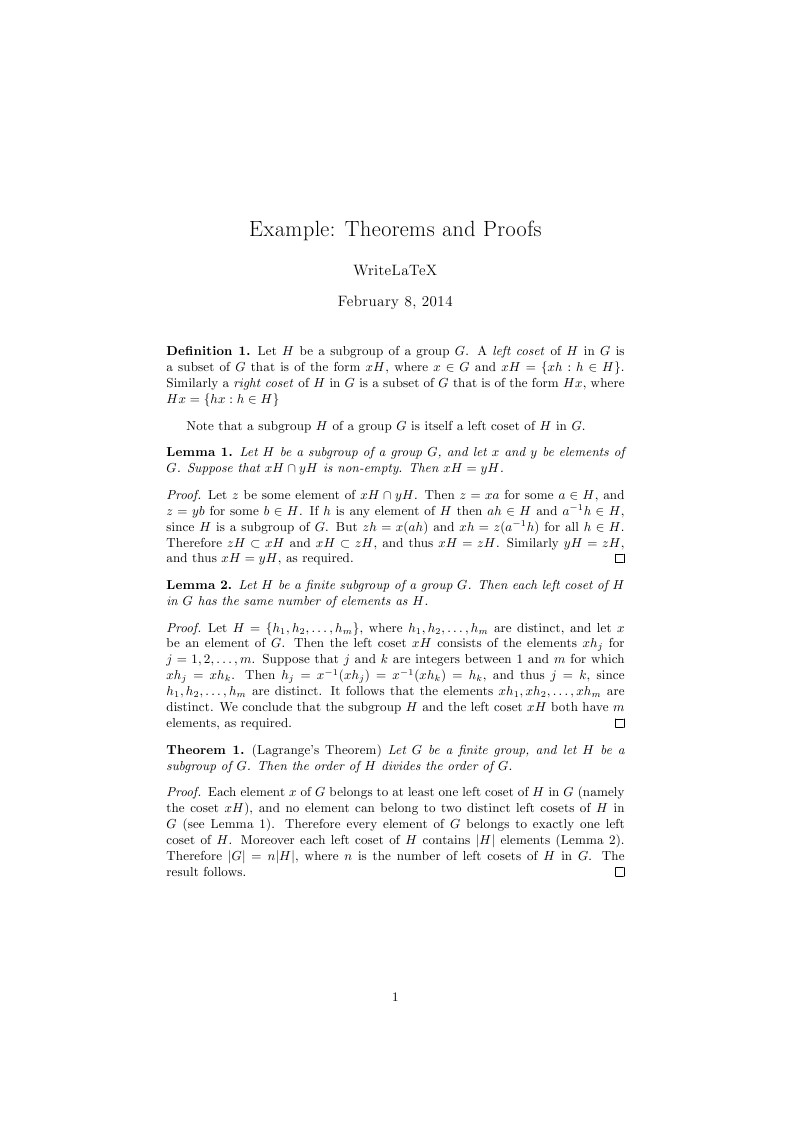
Example: Theorems and Proofs
Last Updated:
12 years ago
License:
Other (as stated in the work)
Abstract:
Example: Theorems and Proofs

\begin
Discover why over 20 million people worldwide trust Overleaf with their work.

\begin
Discover why over 20 million people worldwide trust Overleaf with their work.
%
% This example is based on:
% http://www.maths.tcd.ie/~dwilkins/LaTeXPrimer/Theorems.html
%
\documentclass[a4paper]{article}
\usepackage[english]{babel}
\usepackage[utf8x]{inputenc}
\usepackage{amsmath,amsthm}
\title{Example: Theorems and Proofs}
\author{WriteLaTeX}
\theoremstyle{definition}
\newtheorem{definition}{Definition}
\theoremstyle{plain}
\newtheorem{theorem}{Theorem}
\newtheorem{lemma}{Lemma}
\begin{document}
\maketitle
\begin{definition}
Let $H$ be a subgroup of a group~$G$. A \emph{left coset}
of $H$ in $G$ is a subset of $G$ that is of the form $xH$,
where $x \in G$ and $xH = \{ xh : h \in H \}$.
Similarly a \emph{right coset} of $H$ in $G$ is a subset
of $G$ that is of the form $Hx$, where
$Hx = \{ hx : h \in H \}$
\end{definition}
Note that a subgroup~$H$ of a group $G$ is itself a
left coset of $H$ in $G$.
\begin{lemma}
\label{LeftCosetsDisjoint}
Let $H$ be a subgroup of a group $G$, and let $x$ and $y$ be
elements of $G$. Suppose that $xH \cap yH$ is non-empty.
Then $xH = yH$.
\end{lemma}
\begin{proof}
Let $z$ be some element of $xH \cap yH$. Then $z = xa$
for some $a \in H$, and $z = yb$ for some $b \in H$.
If $h$ is any element of $H$ then $ah \in H$ and
$a^{-1}h \in H$, since $H$ is a subgroup of $G$.
But $zh = x(ah)$ and $xh = z(a^{-1}h)$ for all $h \in H$.
Therefore $zH \subset xH$ and $xH \subset zH$, and thus
$xH = zH$. Similarly $yH = zH$, and thus $xH = yH$,
as required.
\end{proof}
\begin{lemma}
\label{SizeOfLeftCoset}
Let $H$ be a finite subgroup of a group $G$. Then each left
coset of $H$ in $G$ has the same number of elements as $H$.
\end{lemma}
\begin{proof}
Let $H = \{ h_1, h_2,\ldots, h_m\}$, where
$h_1, h_2,\ldots, h_m$ are distinct, and let $x$ be an
element of $G$. Then the left coset $xH$ consists of
the elements $x h_j$ for $j = 1,2,\ldots,m$.
Suppose that $j$ and $k$ are integers between
$1$ and $m$ for which $x h_j = x h_k$. Then
$h_j = x^{-1} (x h_j) = x^{-1} (x h_k) = h_k$,
and thus $j = k$, since $h_1, h_2,\ldots, h_m$
are distinct. It follows that the elements
$x h_1, x h_2,\ldots, x h_m$ are distinct.
We conclude that the subgroup~$H$ and the left
coset $xH$ both have $m$ elements,
as required.
\end{proof}
\begin{theorem}
\emph{(Lagrange's Theorem)}
\label{Lagrange}
Let $G$ be a finite group, and let $H$ be a subgroup
of $G$. Then the order of $H$ divides the order of $G$.
\end{theorem}
\begin{proof}
Each element~$x$ of $G$ belongs to at least one left coset
of $H$ in $G$ (namely the coset $xH$), and no element
can belong to two distinct left cosets of $H$ in $G$
(see Lemma~\ref{LeftCosetsDisjoint}). Therefore every
element of $G$ belongs to exactly one left coset of $H$.
Moreover each left coset of $H$ contains $|H|$ elements
(Lemma~\ref{SizeOfLeftCoset}). Therefore $|G| = n |H|$,
where $n$ is the number of left cosets of $H$ in $G$.
The result follows.
\end{proof}
\end{document}